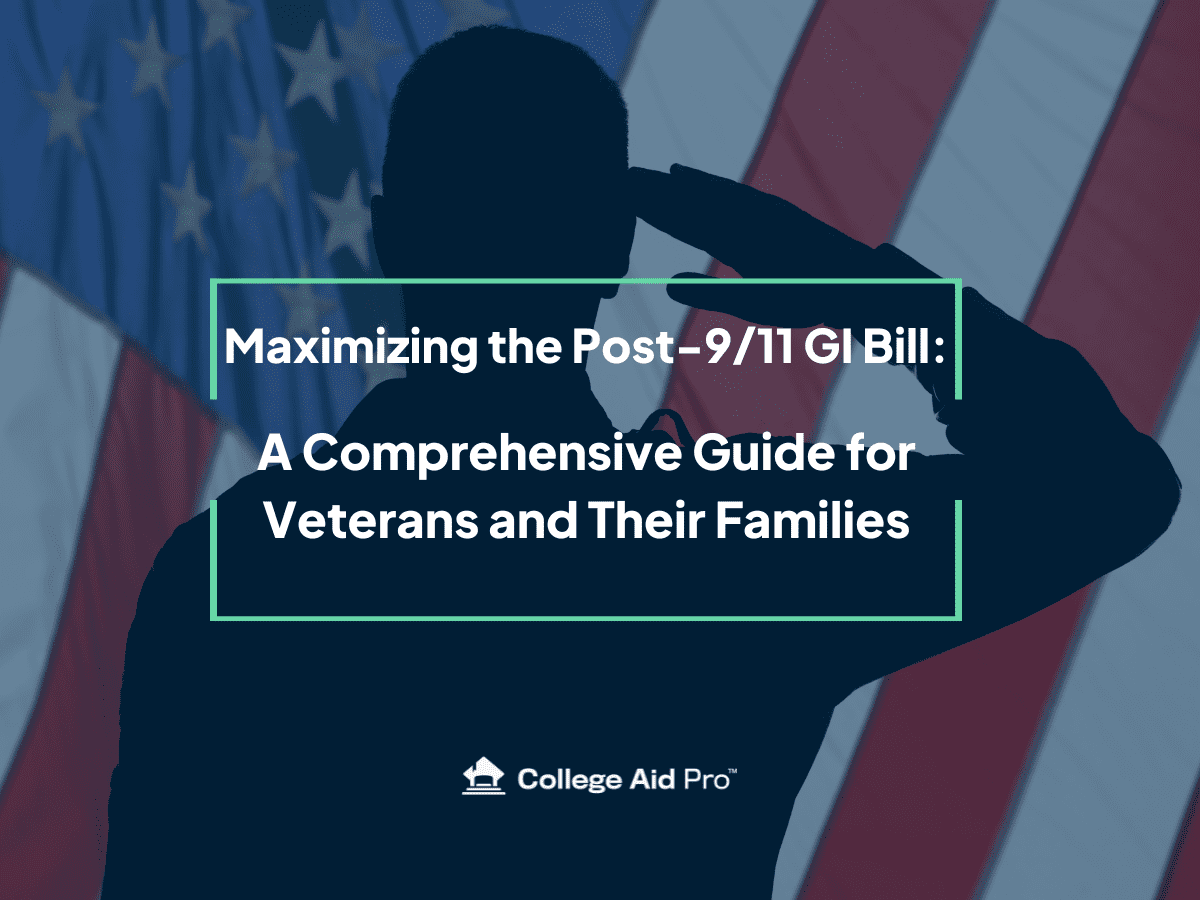Understanding the Post-9/11 GI Bill Benefits for Veterans & Their Families
At College Aid Pro, we’re here to help families make smart, informed choices about paying for college—because we know know that every family is unique. For our military families with Post-9/11 GI Bill benefits, we want to make sure you fully understand what you’re entitled to and how to make the most of it. This can make a big difference in covering college costs and even how you shop for colleges. Our goal is simple: to help you navigate valuable benefits like tuition coverage, housing allowances, and the Yellow Ribbon Program so you can stretch every dollar. With our guidance, you can confidently leverage the GI Bill to make higher education affordable and achievable for your family.
In 2008, Congress passed the Post-9/11 GI Bill and it went live in 2009, introducing sweeping changes that now allow military members to transfer educational benefits to their families. This is an outstanding benefit that helps cover the cost of tuition, housing, books, and supplies, but it’s important that you understand the specifics to maximize these GI Bill benefits and best support your family’s education.
The Post-9/11 GI Bill Explained: 8 Things Every Veteran Needs to Know
The Post-9/11 GI Bill offers a range of educational benefits for service members, veterans, and their families, including coverage for tuition and fees, a housing allowance, a stipend for books and supplies, and a potential relocation benefit. Here’s a breakdown of each component to help you understand what’s available:
1. Tuition and Fees Coverage Under the Post-9/11 GI Bill
One of the main advantages of the Post-9/11 GI Bill is its extensive tuition and fees coverage for public institutions. The Department of Veterans Affairs (VA) covers the full cost of public in-state tuition and fees, which means the amount covered can vary from state to state.
For example, if you live in Missouri and your child wants to attend the University of Missouri, the tuition will be fully covered. However, if they choose a private institution like Washington University in St. Louis, which has a tuition of about $60,000 per year, the VA will only cover up to $27,000. This is the highest public school tuition in Missouri. This means you would need to find an additional $33,000 per year to cover the remaining costs.
2. The Yellow Ribbon Program: Additional Support for Private Tuition
To help bridge the tuition gap at private schools, some institutions participate in the Yellow Ribbon Program. This partnership between schools and the VA covers additional tuition beyond the GI Bill’s limits, with the VA matching school contributions dollar-for-dollar.
The amount covered can vary by school, with some offering a few thousand dollars and others covering full private tuition. It’s important to check if the school you are considering is a Yellow Ribbon school and understand any limitations they may have on the number of scholarships available. For further details, visit the VA’s Yellow Ribbon Program page here.
3. Housing Allowance: GI Bill Benefits for Room and Board
The Post-9/11 GI Bill provides a housing allowance based on the ZIP code of your primary school. This allowance is calculated at the E5 rate with dependents and is tax-free. However, it’s important to note that:
- Active-duty members who transfer benefits to their spouse will not receive this allowance.
- If taking online-only classes, the allowance will be 50% of the national average housing allowance.
These GI Bill housing benefits can make a substantial difference in the affordability of college by helping to cover room and board expenses.
4. Books and Supplies Stipend
The Post-9/11 GI Bill also includes a stipend for books and supplies, up to $1,000 per year. Additionally, a one-time $500 relocation allowance is available for those residing in very rural areas, making it easier for qualifying students to attend schools that may otherwise be challenging to access.
5. Duration of GI Bill Benefits for Veterans and Dependents
If you served at least 36 months of active duty, you’re eligible for the full Post-9/11 GI Bill benefit, which includes 36 months of education support (typically covering a four-year degree). Partial benefits are available for those with less than 36 months of service. It’s also important to note that if you have even one day of benefits left at the start of a semester, the VA covers the entire semester—allowing students to make the most of their veterans’ education benefits.
6. Transferability of Post-9/11 GI Bill Benefits to Family Members
The transferability of Post-9/11 GI Bill benefits is truly fantastic. This allows service members who earned these benefits to transfer them to family members.
To qualify, the service member must:
- Be on active duty or in the Selected Reserve
- Have completed at least six years of service
- Commit to an additional four years of service
- Ensure that the dependent is registered in the Defense Enrollment Eligibility Reporting System (DEERS)
- If you have received a Purple Heart, you do not need to meet the service requirement, but you must request the transfer while still on active duty
This transferability is especially beneficial for military families planning long-term education funding.
7. Flexibility in Transferring GI Bill Benefits
As the service member, you have control over the benefits until they are used. Transfers can be made through the MilConnect website while on active duty and after separation. Benefits are transferred by month, and it’s a good practice to transfer at least one month to each potential beneficiary. This ensures that if something happens to the service member, the beneficiaries can still reallocate the benefits.
However, if you separate from active duty and have another child afterward, that child will not be eligible for the benefits. The military member can transfer months to multiple children or a spouse and the transfers do not need to be equal. Additionally, if a child or spouse doesn’t use the full amount that’s been transferred to them the member can reallocate the remaining months to themself, another child or their spouse.
8. Using Post-9/11 GI Bill Benefits for Education
Once eligibility requirements are met, GI Bill benefits can be used immediately, with some key timelines to note:
- If your service ended before January 1, 2013, benefits expire after 15 years.
- If your service ended on or after January 1, 2013, there’s no expiration.
- Children must use their GI Bill benefits before age 26.
It’s important to plan accordingly to ensure the benefits are used effectively. You will need to apply to use the benefits. Once you received your approval, you’ll need to work with the VA certifying official at your school to find out how you go about getting your benefits applied.
Maximizing Your Post-9/11 GI Bill Benefits
The Post-9/11 GI Bill provides extensive support for service members, veterans, and their families. From tuition coverage to housing stipends and flexible transfer options, these benefits can significantly offset college costs. Whether you are planning for your own education or that of your family members, the Post-9/11 GI Bill offers a range of options to help you achieve your educational goals.
For personalized planning, create a FREE MyCAP account to see how the GI Bill affects your financial aid. Fill out your profile and select the schools you are considering. The easiest way to currently reflect the GI Bill in the software is to add it as a parent pledged asset at whatever the annual GI Bill cap is ($28,937 for the 2024-25 school year) times the number of years of benefit the student will have available.
Mike is one of College Aid Pro’s dedicated experts on veteran education benefits. If you’d like personalized guidance on using the GI Bill, navigating the Yellow Ribbon Program, or maximizing veteran and dependent benefits, book a consultation with Mike here to explore tailored strategies for your family’s education planning.
Frequently Asked Questions (FAQs)
1. What does the Post-9/11 GI Bill cover?
The GI Bill covers public in-state tuition, housing allowances, a book and supplies stipend, and, in some cases, a rural relocation benefit.
2. How does the Yellow Ribbon Program work?
The Yellow Ribbon Program bridges tuition costs at private institutions, with the school and VA splitting the additional expense.
3. Can I transfer my GI Bill benefits to my children?
Yes, if you’ve served at least six years and commit to four more years, you can transfer benefits to family members through DEERS.
4. How much is the GI Bill housing allowance?
It varies by ZIP code and is calculated at the E5 rate for dependents. Online-only students receive 50% of the national average.
5. Do Post-9/11 GI Bill benefits expire?
If your service ended before January 1, 2013, benefits expire after 15 years. For service after this date, benefits do not expire.
6. How do I maximize my GI Bill benefits?
Consider Yellow Ribbon schools, plan for housing expenses, and transfer benefits wisely among eligible family members.



